Intel launches Tiger Lake-H mobile CPUs for gaming notebook PCs - pellegrinoturam1981
Just a couple of short months after Intel launched the 11th-gen Nitty-gritty H35-serial publication microprocessors for mobile gambling, Intel is at it again: On Tuesday, Intel officially launched the 11th-gen Core "Tiger Lake" H-series processors for mainstream and gaming laptops.
The line includes five new processors, including the premium, unlocked Heart i9-11980HK, the Core i7-11800H, and a pair of CORE i5 processors. Quad-core processors have disappeared from the lineup. Instead, the spick-and-span chips let in hyperthreaded six-core and eight-core processors, offering double the cores of the 11th-gen Panthera tigris Lake cores Intel launched in September.
Versus last year's 10th-gen Core floating gaming chips, base CORE clock frequencies are somewhat up across the display board. The maximum single-core further clock has dipped, though—mayhap a black mark for gamers. Withal, Intel is formerly again publishing its all-core turbo speeds, and they'Re considerable. Substantiated memory speeds wealthy person climbed from DDR4-2933 to DDR4-3200. World power has dropped, too: Virtually all of the new processors are rated at 35W, sooner than 45W. Overall, Intel claims that the Tiger Lake-H platform offers three times the platform bandwidth of its predecessor, with a commingle of 20 PCI Carry 4.0 and 24 PCI Express 3.0 lanes. Oh, and integrated graphics have returned, too.
Intel would also suchlike to tacitly prompt you that demand for rival AMD's Ryzen processors is outstripping supply. Intel executives suppose they'll ship more a cardinal of the 11th-gen Core H processors to customers by launch, as part of to a greater extent than 80 rising designs. They'll besides keep going selling 10th-gen H-series chips. Naturally, Intel believes its revolutionary 11th-gen Core H parts outperform AMD's Ryzen 9 5000 processors in gambling, away about 11 to 22 percent.
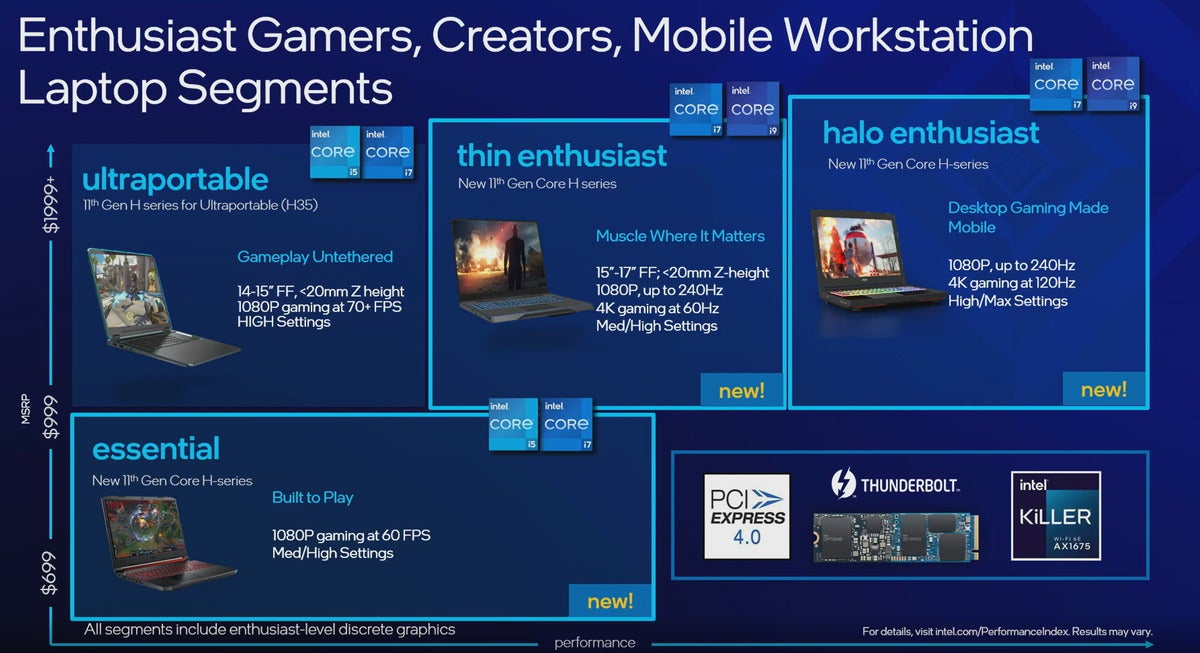 Intel
Intel Here's how Intel sees the gaming notebook computer market breaking pour down.
Inside a Tiger Lake-H gaming notebook
it's been a intrusive year or so for Intel. Let's recap: Last April, Intel launched the 10th-gen Intel "Comet Lake"-H processors. The Core i7-10875H at last reached 8 cores and 16 threads, spell the superior Core i9-10980HK topped out at 5.3GHz. Our tests of the Core i7-10875H proved it was indeed the fastest Core i7 processor to date, though our tests of AMD's Ryzen 4000 Mobile processor showed Ryzen keeping pace. In January, Intel added new 10th-gen Core i5 and Core group i7 Comet Lake-H chips to the batting order.
January's launch, not now's, was Intel's first 11th-gen mobile Core debut, when it pioneered a new ultraportable gaming segment with the Core H35 series. It was then that PCI Show 4.0, Wi-Fi 6E and Intel's Killer networking engineering arrived in Intel's 11th-gen mobile processors. Now they've migrated to the mainstream gaming line also.
What does an 11th-gen Sum mainstream gaming notebook include? According to Kim Algstam, interim undiversified manager of Intel's Innovation and Enthusiast team and director of Intel's enthusiast laptop excogitation team, Intel's aiming its Core i5 H-series chips at "essential" gaming notebooks for every bit little as $699 to $999, running at 1080p resolutions at Average to High settings. To a greater extent expensive models leave be priced 'tween $999 to $1,999: 15- to 17-column inch notebooks running at either 1080p/240Hz or 4K/60 resolutions, and more powerful "glory fancier" notebooks running at 4K/120 resolutions at maxed-outgoing settings. (Up to 1080p/360 and 4K/120 displays are supported, too.) Whol will include discrete, enthusiast-course GPUs from either Nvidia or AMD.
Interestingly, Algstam said Intel is helping affirm a new display size of 16 inches, which would break up the difference between the more traditional 15-inch and 17-in play laptops. Intel also sees 1440p resolutions as the "new gaming standard."
Here are Intel's 11th-gen Core mobile processors
The computer architecture of the chips themselves doesn't hide any surprises. These are 10nm chips, fashioned around the Willow Cove CPU cores Intel talked dormy last year. However, Intel executives same that though the GPU cores are designed around the Xe architecture, they're being branded equally Intel UHD Graphics somehow. That's calm a change from the 10th-gen "Comet Lake-H" chips, when Intel said gamers simply preferred discrete nontextual matter and didn't need an integrated GPU.
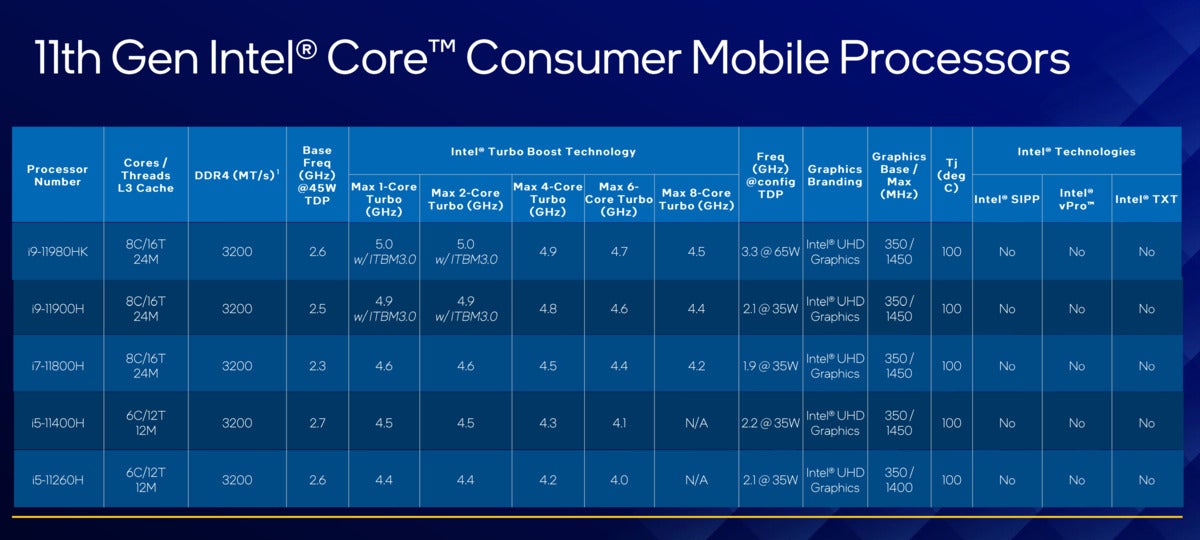 Intel
Intel Intel is oblation five new 11th-gen Core H-series chips for consumers.
Intel's chart, above, includes several different scenarios. The base clock upper of the Substance i9-11980HK, for example, is just 2.6GHz. Intel is also showing that chips the like the Core i9-11900H, while designed for 35W, will typically run inside of a 45W notebook and at a slightly faster pelt along when doing so.
At 45 Watts, these 35W chips will run a second faster. When boosted using the Intel Turbo Boost Max 3.0 technology, either one surgery 2 "blessed" cores give the axe reach 5.0GHz for a short meter. Scenarios like our Cinebench benchmark will push buttonall of the cores on that cut off to 4.5GHz, consequently pushing up the power pulmonary tuberculosis to as commanding as 135 watts, reported to Ryan Shrout, Intel's performance Guru.
The 'K' suffix designates an unsecured part that tail equal overclocked. Intel executives also alluded to "partially overclockable" chips that can use Intel's Speed Optimizer, but didn't clarify which ones they were.
Intel also launched several similar processors for the inferior segment, featuring vPro technology.
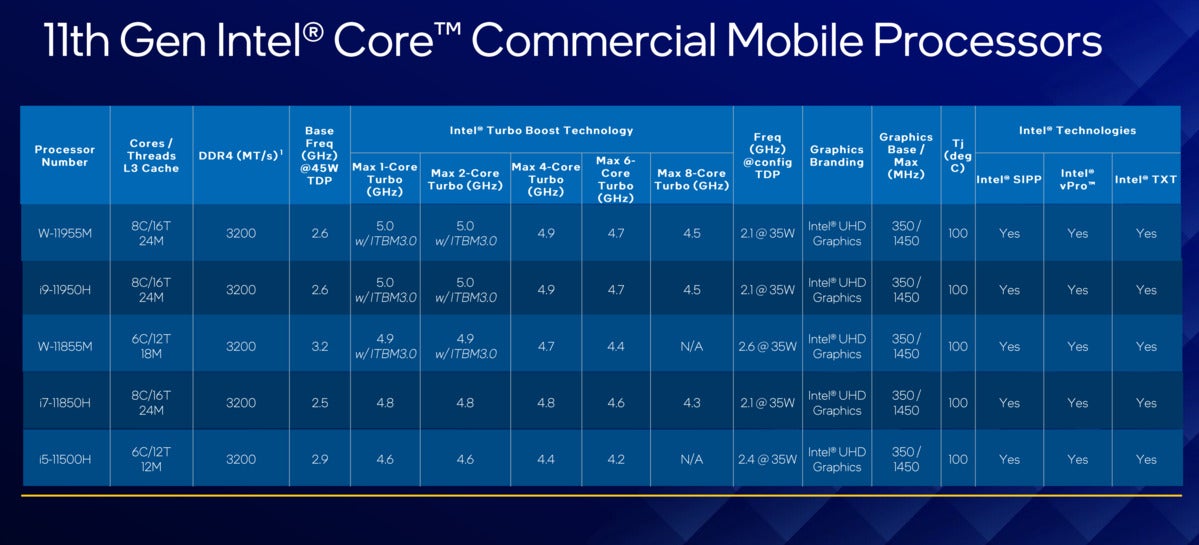 Intel
Intel Intel's performance benchmarks for its 11th-gen Core-H mobile processors
How fast is the new 11th-gen Tiger Lake H processor? Intel claims in that respect's a 19-percent generation-to-generation performance increase (as premeditated by the SPEC_int_rate_base2017 benchmark) between the Core i9-11980HK processor and the earlier Core i9-10980HKchip. In gaming, Intel says that you'll see frame rate improvements between 5 and 21 pct in some popular titles.
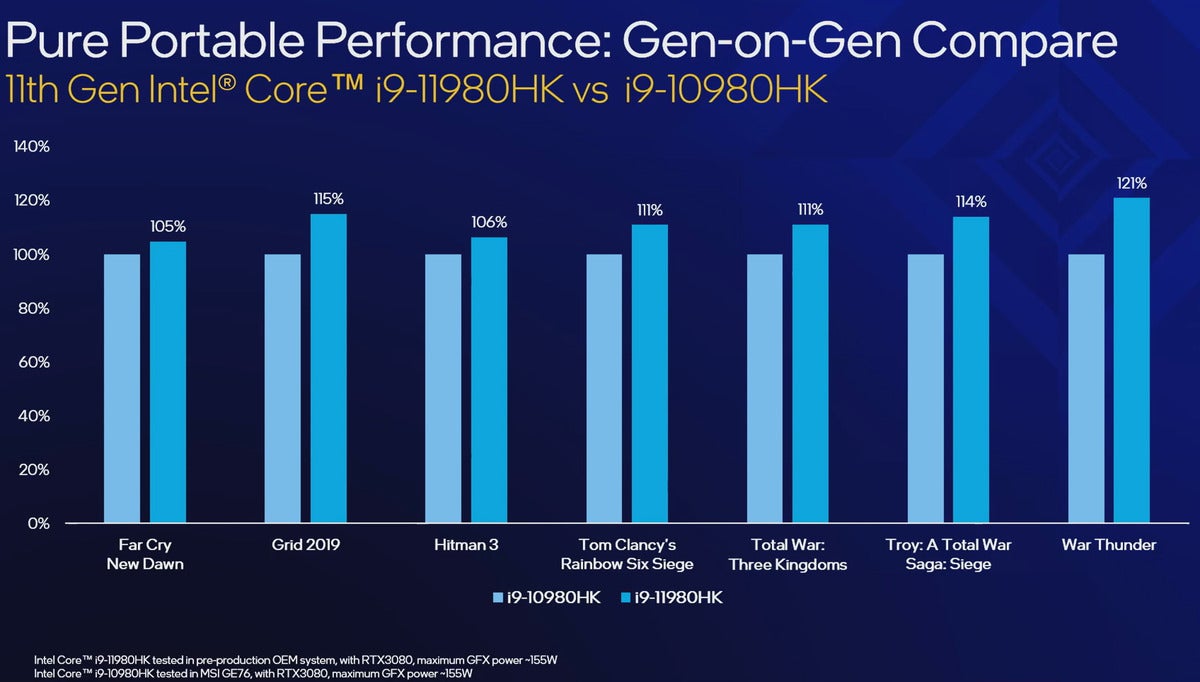 Intel
Intel Hera's what Intel claims are the generational improvements over the older 10th-gen Congress of Racial Equality-H chips. Both systems are using an Nvidia GeForce RTX3080 GPU.
Intel ran same benchmarks comparing the top-of-the-line Gist i9-11980HK versus the Ryzen 9 5900HX, AMD's most potent processor. Again, Intel is using gaming equally the point of comparison, with an RTX 3080 supplying the graphics horsepower. In the games Intel selected, the 11980HK outperforms the 5900X away up to 26 percent.
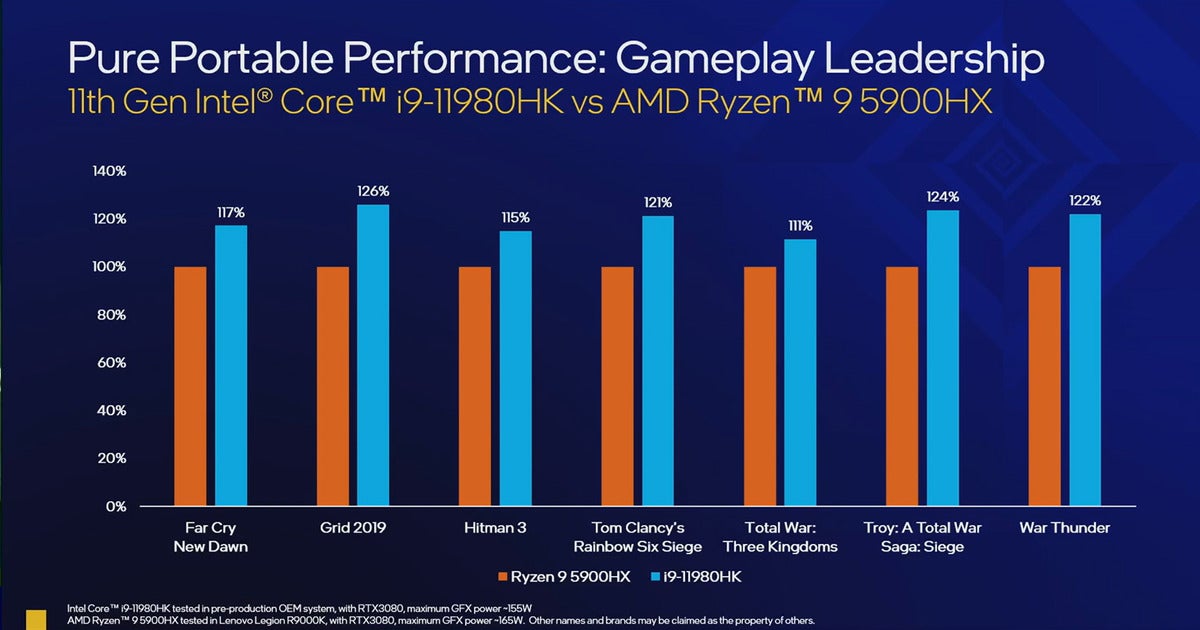 Intel
Intel Intel is claiming that its top-of-the-telephone line Core i9-11980HX handily outperforms AMD's Ryzen.
Intel used a similar subset of games to draw a comparability 'tween the much more affordable Core i5-11400H and the Ryzen 9 5900HS. Here, the cardinal processors are more closely matched, with Intel admitting that its rival outperforms it in certain situations. Intel, still, claims that its exhibit notebook is honorable 16.5mm thick and consumes 65W, piece the Ryzen system measures as much as 20mm thick and consumes up to 80 watts.
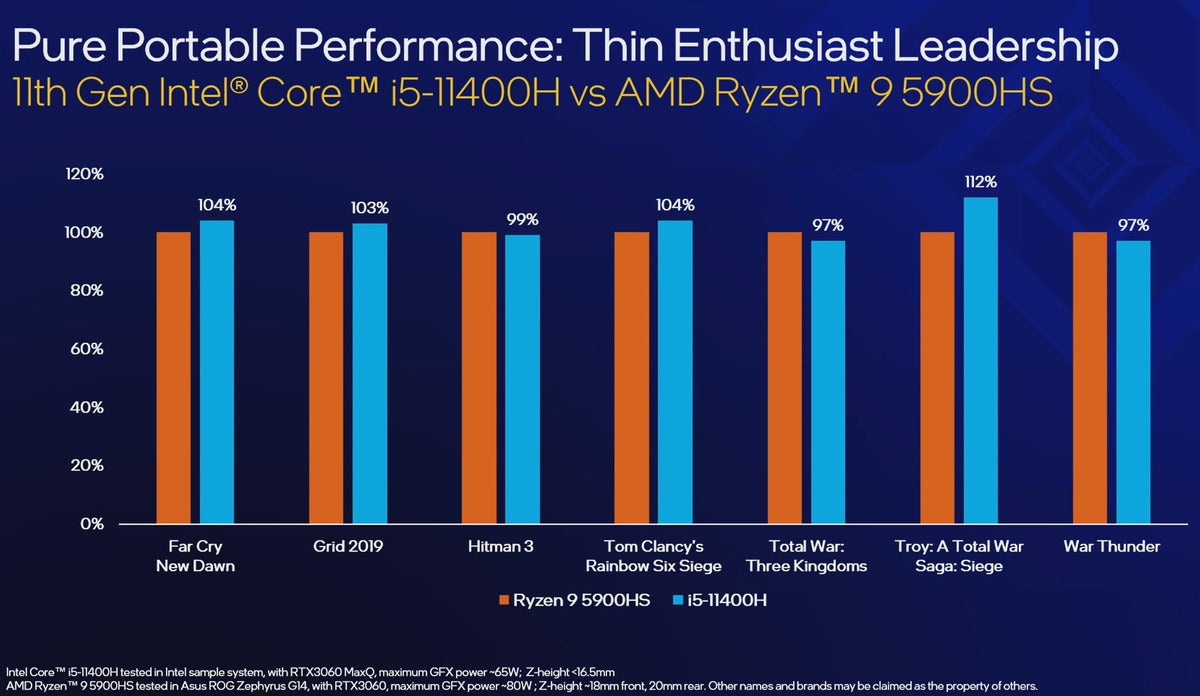 Intel
Intel Many gamers will buy a Core i5 system of rules simply because it offers a frown terms without trading cancelled much in the way of performance. Here, Intel's Core group i5-11400H is compared to the Ryzen 9 5900HS. Remember, these are Intel's benchmarks.
In depicted object creation, Intel is claiming a 22-percent contemporaries-over-generation improvement in Photoshop, and 20 percent in video creation. Intel believes it holds 24-percentage and 18-percent advantages in those two, respectively, over Ryzen 9 5900X. Intel's Shrout said He believes those improvements stem from the overall computational gains from one generation to the opposite, plus roughly of the AI-particular enhancements like DLBoost that Intel has built in.
How does Intel's 11th-gen Core match busy Apple's M1? "We don't have any of that information Here to share today," Shrout said.
The improvements Tiger Lake-H adds to mobile PCs
As AMD's Ryzen has risen to dispute Intel's Meat chips straight, Intel has shifted gears to punctuate any of the other advantages an Intel Personal computer brings beyond raw performance. These "platform" improvements speck on other aspects of the PC that may be unparalleled to Intel, generally emphasizing additional bandwidth such as the unexampled 40Gbps Bombshell 4 specification for connecting external storage. For better or worse, Thunderbolt is even largely exclusive to Intel PCs, with exceptions like this Asus desktop motherboard. Intel isn't even mentioning USB4, though the USB4 stipulation and Thunderclap 4 run along hand in paw.
For Intel's new Tiger Lake-H laptops, a few capabilities stand for out. For unrivalled, the platform now supports DDR4 3200, which represents a humble 9-percent boost from the DDR4 2933 memory speeds of the 10th-gen parts.
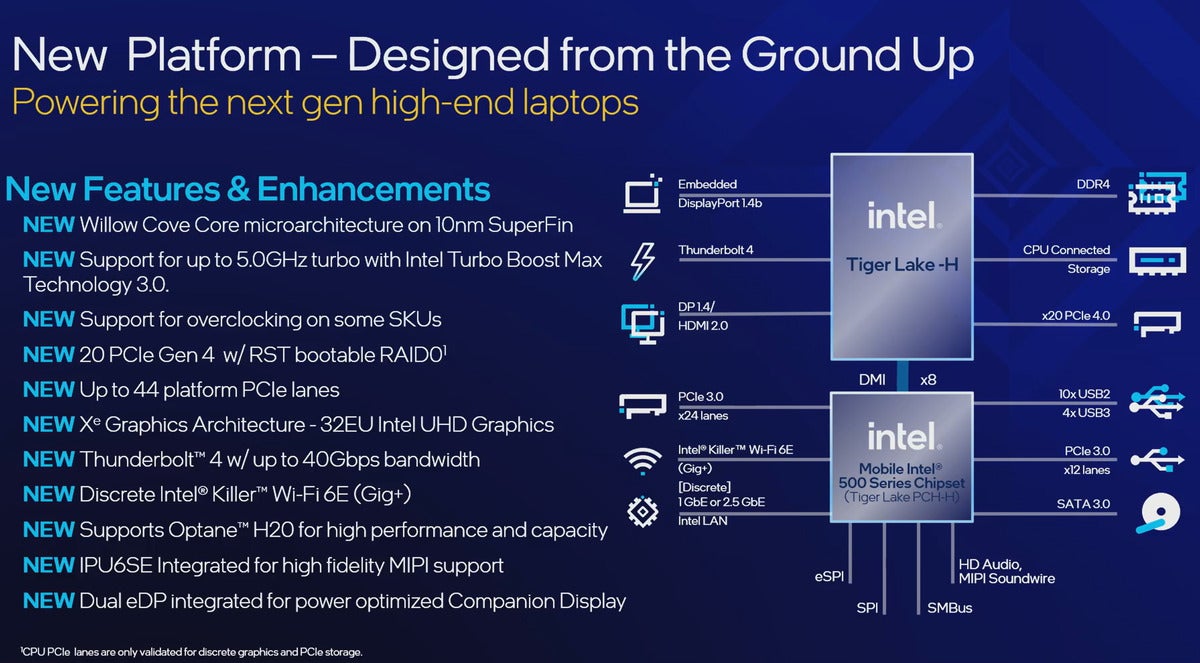 Intel
Intel A sum-up of the improvements that Intel has added to its perambulating 11th-gen Core chopine, code-titled Panthera tigris Lake H.
These days, the PCI Fast bus is primarily used just for discrete graphics and storage. Intel's Tiger Lake-H laptops turn back 20 lanes of PCI Express 4.0 I/O like a shot attached to the CPU, allowing for an x16 discrete GPU summation an x4 SSD for intimate PC storage.
The DMI link between the host CPU and the accompanying 500-serial PCH chipset has besides been widened, to an x8 interface. All this agency that the available bandwidth 'tween the I/O silicon chip and the C.P.U. has doubled, allowing the PCH an additional 24 lanes of PCI Extract 3.0 storage to an external GPU operating theater additional SSDs. These are PCI Give tongue to 3.0 lanes, granted, with half the bandwidth of the PCIe 4.0 lanes forthwith attached to the CPU.
Still, you May see notebooks that combine SSDs attached to both PCIe 4 and PCI 3, to create Foray into 0 arrays that could step-up a laptop's storage performance even farther. And, of course, Intel has also included support for its H20 Optane drives.
Because Intel envisions its Panthera tigris Lake-H notebooks being used with foreign artwork, the platform's integrated graphics come as a little routine of a mystery. These chips include co-ed graphics based on the Xe architecture, and with 32EUs to boot—but they're being marketed as Intel UHD Nontextual matter. They DO include an unexpected bonus: They've been designed to bring off with two external DisplayPort connections, specifically for the secondary "companion displays" that own begun cropping up in plural-shield laptops suchlike the Asus ZenBook Pro Duo. IT's just to expect that they'll be able to maltreat in and power day-to-day web and Office work versus using the international GPU, serving preserve your laptop computer's battery sprightliness. They besides support AV1 decryption in ironware.
Finally, these new 11th-gen Tiger Lake platforms include Intel's Killer networking technology, which Intel acquired a yr ago for gaming PCs. The new notebooks will admit livelihood for Wi-Fi 6E, which adds a new dedicated 6GHz Wi-Fi channel for (hopefully) little wireless over-crowding.
With a global semiconductor shortage, a cryptocurrency craze, and opportunistic resellers and bots snapping up the addressable provision of discrete desktop GPUs, gaming notebooks are not scarce a nice luxury—in certain cases, they may be the only way for gamers to be competent to play the latest games. Intel's new 11th-gen Core H-series raisable parts may encounter an large importance as the weeks progress.
Source: https://www.pcworld.com/article/394541/intel-launches-11th-gen-tiger-lake-h-cpus-for-gaming-notebooks.html
Posted by: pellegrinoturam1981.blogspot.com


0 Response to "Intel launches Tiger Lake-H mobile CPUs for gaming notebook PCs - pellegrinoturam1981"
Post a Comment